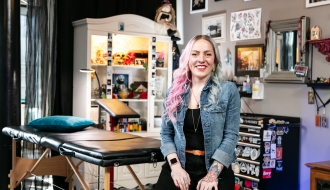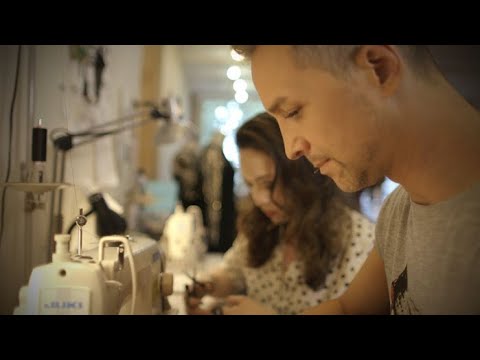Career Overview
Theatre, fashion, exhibit and other creative designers conceptualize and produce designs for film, television, theatre and video productions, garments and textiles, displays and exhibits, and other creative items such as jewellery and trophies.
People in this occupation:
- May be employed as a theatre designer by performing arts, film and television companies and by festivals
- May be employed as a fashion designer by clothing and textiles companies
- May be employed as an exhibit designer by museums
- May be employed as a creative designer by manufacturing establishments
- May be employed as an independent designer working for themselves
Job Titles
Duties
Designers:
- Review and analyze client needs and help develop a concept into an original design
- Prepare sketches, diagrams or prototypes, either by hand or with the aid of a computer to illustrate designs
- Perform administrative tasks, such as reviewing catalogues and ordering samples
- May supervise assistants
There are many areas of design expertise such as designing jewellery, fabric, toys, trophies and haute couture. Most designers specialize in a particular area, such as those described under Special duties.
Special duties
Theatre designers:
Theatre designers design and create sets, scenic environments, properties, costumes and lighting for theatre, film and video productions, operas and ballets, by preparing sketches or scale models to guide construction. They may specialize in costume, lighting or set design.
Fashion designers:
Fashion designers design and create clothing and accessories. They may specialize in men's, women's or children's apparel or in different lines such as sportswear, footwear or formal wear.
Exhibit designers:
Exhibit designers plan and develop permanent and temporary or moveable exhibits and displays for museum exhibitions, trade shows, conventions and other exhibitions.
Earnings
Earnings is income that workers receive in exchange for their labour. Depending on the type of employment, earnings can be in the form of wages (hourly), salaries (fixed monthly or annual) or self-employed earnings.
Work Environment
# Workers Employed
2,325% Employed Full Time
41%Working conditions and places of employment vary depending on the type of work. Designers employed by manufacturing establishments, large corporations or design firms generally work regular hours in office settings, however, they may have to adjust their work day to suit client schedules and deadlines, meeting in the evening or on weekends if necessary.
Designers in smaller design consulting firms or those who freelance generally work on a contract basis. They may conduct business in their own offices or studios or in client homes or offices. They may also travel to other locations, such as showrooms, design centres, manufacturing facilities and client exhibits.
Fashion designers may be required to travel to production sites across the country and overseas. As well, fashion and interior designers frequently work under deadlines and may be required to work extra hours to complete a job.
Some designers (i.e., set and exhibit designers) may also help to construct and install displays, which may require moving lumber and heavy materials and performing some carpentry and painting. As well, work may be done under pressure to make changes by deadlines.
Career Pathways
Many options are open to designers once they are employed in this group. Individuals often begin as design assistants before advancing to designer positions.
Progression to supervisory, management or head designer positions is possible with experience. Experienced designers may also choose to become self-employed.
Occupational Interests
It’s important to understand what kinds of occupations align with your interests.
For more about occupational interests visit Skills for the Future Workforce > Characteristics.
Here are the top occupational interest(s) for this career profile:
Education, Training and Skills
Theatre, fashion, exhibit and other creative designers are typically required to complete a certificate, diploma, degree or other professional training program in design. Other requirements may include:
- Training in the use of computer-aided design (CAD) software
- Developing a portfolio of work, which demonstrates their creativity and quality of work to prospective clients and employers
Designers should be creative and have good computer skills, and need excellent organizational and communication skills. They should be detail oriented and able to work under tight schedules to meet deadlines.
Education programs in B.C.

Top Skills
Every job calls for a certain set of skills. Knowing those skills is the first step in finding a good career fit.
Here, you will find the 10 most relevant workplace skills. Some are more important to achieving success in a certain career than others. These skills may come naturally to you or you may need to gain them through education, training and experience.
See the list of work-related skills below, ranked in order of importance for this career. Check out the list and see if this career matches your skills—take that first step!
Giving full attention to what other people are saying, taking time to understand the points being made, asking questions as appropriate, and not interrupting at inappropriate times.
Using logic and reasoning to identify the strengths and weaknesses of alternative solutions, conclusions or approaches to problems.
Understanding written sentences and paragraphs in work-related documents.
Talking to others to share information effectively.
Managing one’s own time and the time of others.
Being able to solve novel, ill-defined problems in complex, real-world settings.
Considering the relative costs and benefits of potential actions to choose the most appropriate one.
Adjusting actions in relation to others' actions.
Being aware of others’ reactions and understanding why they react as they do.
Understanding how new information could be used to solve current and future problems in making decisions.
Labour Market Statistics
Discover data, facts and information that have been gathered and analyzed. Learn about the characteristics of the economy and labour market in B.C.
Employment
Find out about employment types and trends by region and industry.
Employment
2,325Employment by Region







| Region | Employment | % Employment of this Occupation |
|---|---|---|
| Cariboo | 10 | 0.4% |
| Kootenay | 30 | 1.3% |
| Mainland/Southwest | 2,005 | 86.2% |
| North Coast and Nechako | 15 | 0.6% |
| Northeast | 0 | 0.0% |
| Thompson-Okanagan | 80 | 3.4% |
| Vancouver Island/Coast | 180 | 7.7% |
Labour Market Outlook
The B.C. Labour Market Outlook is a 10-year forecast of the expected supply and demand for labour in the province. It’s usually updated every year. The purpose is to provide British Columbians with the knowledge to make informed decisions on careers, skills training, education and hiring.
Forecasted Job Openings (2025-2035)
880Forecasted Job Openings
Forecasted Employment Growth Rate
Composition of Job Openings
Job Openings by Region (2025-2035)







| Region | Job Openings | Avg. Annual Employment Growth |
|---|---|---|
| Cariboo | Not available | Not available |
| Kootenay | 10 | 0.1% |
| Mainland/Southwest | 730 | 1.1% |
| North Coast and Nechako | Not available | Not available |
| Northeast | Not available | Not available |
| Thompson-Okanagan | 30 | 1.2% |
| Vancouver Island/Coast | 100 | 1.9% |
Industry Highlights
Learn about the opportunities in B.C.'s major industries, including employment trends, earning potential, locations of work and more.
Forecasted Job Openings by Industry
| Industry | Job Openings (2025-2035) |
|---|---|
| Information, Culture and Recreation | 290 |
| Retail Trade | 260 |
| Professional, Scientific and Technical Services | 250 |
| Manufacturing | 40 |
| Repair, Personal and Non-Profit Services | 20 |
Insights from Industry
Job openings in upcoming years will arise from a combination of new job growth and the need to replace retiring workers.
In the last decade B.C.'s film and television production activity has expanded rapidly due to a large pool of talented workers, a wide variety of shooting locations and extensive studio and post-production facilities. Currently, B.C. is the third-largest motion picture production centre in North America. This growth will create a strong demand for costume and set designers, which are primarily employed by film and television production companies.
Fashion design in B.C. has also grown as apparel companies focus local efforts on the design and marketing elements of their business, creating more opportunities for fashion designers and design assistants. Job responsibilities for fashion designers have expanded in recent years to include more research into the preferences of target customers, performance of past lines and the development of marketing materials.
Designers with experience in market research and the development of marketing materials are increasingly in demand by employers. As garment manufacturing shifts overseas, fashion designers are also increasingly required to travel to oversee production.
Designers use computer-assisted design and computer-assisted pattern-making software and these skills are now a prerequisite for employment by most companies, depending on the type of design work undertaken.
Resources
-
Apparel Human Resources Councilwww.apparel-hrc.org
-
Associated Designers of Canadawww.designers.ca
-
British Columbia Museums Associationwww.museumsassn.bc.ca
-
Canadian Media Producers Association (CMPA)www.cmpa.ca
-
Cultural Human Resources Councilwww.culturalhrc.ca
-
Theatre BCwww.theatrebc.org/








